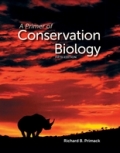
A Primer of Conservation Biology., Fifth Edition incorporates background, theory, and examples in a lively and readable text that will appeal to a wide audience and stimulate interest in conservation biology. The book provides the most up-to-date perspective on many high-profile issues in the field, such as sustainable development, global warming, payments for ecosystem services, and strategies to save species on the verge of extinction. The Primer is divided into nine chapters, focusing successively on biological diversity and its value, the threats to biological diversity, conservation at the population and species levels, protecting, managing and restoring ecosystems, and sustainable development. The book provides many examples of successful conservation approaches,such as one involving sea turtles in Brazil, and ends with suggestions for a future agenda. Throughout, the choice of examples is well balanced to show thefull range of species, ecosystems, and geographic areas of the world. These examples are also selected to demonstrate the controversies in the field, and stimulate thought and discussion. The links between conservation biology and environmental law, environmental economics, philosophy, social sciences and anthropology, park management, and government policy are clearly presented. The book is very well illustrated in full-colour. The reader-friendly text is backedby an extensive bibliography (covering literature through 2012) and a glossary. There is an annotated list of suggested readings, a summary, and discussionquestions at the end of each chapter. Key conservation organizations and their websites are presented in an Appendix. A Primer of Conservation Biology. is ideally suited for use in short undergraduate modules, either as a stand-alonetext or supplemented by outside readings. It can also be used effectively as a supplemental resource in courses in introductory biology, general ecology, population biology, environmental science, and wildlife management. Its broad perspective, concise format, and appealing writing style make the Primer the perfect choice for students, professionals, government policymakers, and others who are eager to learn more about conservation biology. These same qualities give the book a strong appeal to students whose first language is not English. INDICE: PARTI:DEFINING CONSERVATION BIOLOGY.The Nature and Origins of Conservation Biology.Conservation Biology's Ethical Principles.Achievements and Challenges.PART II:WHAT IS BIODIVERSITY?.Species Diversity.Genetic Diversity.Ecosystem Diversity.Biodiversity Worldwide.PART III:THE VALUE OF BIODIVERSITY.Ecological Economics.Direct Economic Values.The Long-Term View: Option Value.Existence Value.Environmental Ethics.PART IV:THREATS TO BIODIVERSITY.Human Population Growth and its Impact.Habitat Destruction.Desertification.Habitat Fragmentation.Edge Effects.Environmental Degradation and Pollution.Global Climate Change.Overexploitation.Invasive Species.Disease.PART V:EXTINCTION IS FOREVER.The Meaning of 'Extinct'.Rates of Extinction.Vulnerability to Extinction.The Problems of Small Populations.Extinction Vortices.PART VI:CONSERVING POPULATIONS AND SPECIES.Applied Population Biology.Conservation Categories.Establishing New Populations.Ex Situ Conservation Strategies.Legal Protection of Species.PART VII:PROTECTED AREAS.Establishment and Classification of Protected Areas.The Effectiveness of Protected Areas.Designing and Networking Protected Areas.Landscape Ecology and Park Design.Managing Protected Areas.PART VIII:CONSERVATION OUTSIDE PROTECTED AREAS.Unprotected Public and Private Lands.Human-Dominated Landscapes.Working with Local People.Ecosystem Management.Restoring Damaged Ecosystems.Targets of Major Restoration Efforts.The Future of Restoration Ecology.PART IX:THE CHALLENGES OF SUSTAINABLE DEVELOPMENT .Sustainable Development in Modern Societies.Conservation Education.International Approaches to Sustainable Development.International Funding.The Role of Conservation Biologists.AppendixA: Some Ongoing Problems and Possible Responses.Appendix B: Selected Environmental Organizations and Sources of Information
- ISBN: 978-0-87893-623-6
- Editorial: Sinauer
- Encuadernacion: Cartoné
- Páginas: 349
- Fecha Publicación: 15/06/2012
- Nº Volúmenes: 1
- Idioma: Desconocido
